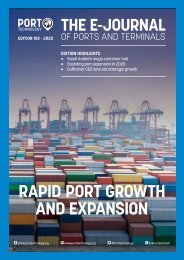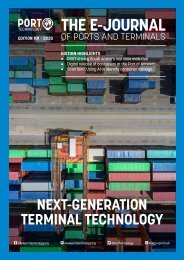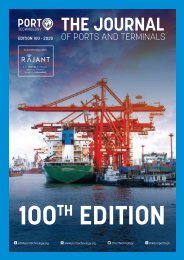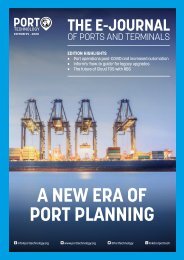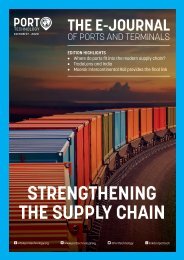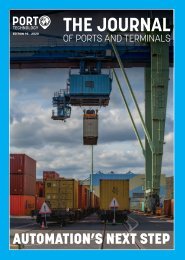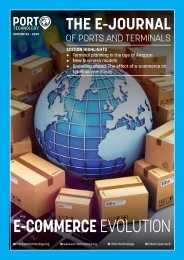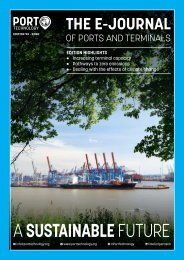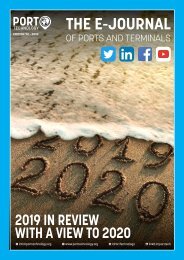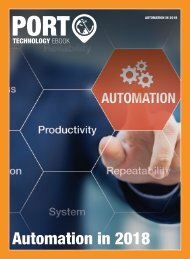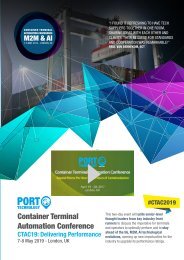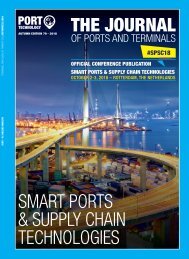Automation Innovations
As we enter the second half of 2020 the full effects of the COVID-19 pandemic are now being realised across the global economy and the port industry. For many, cargo throughput has been significantly decreasing compared with the same period for 2019. For example, the Port of Los Angeles handled 581,665 TEUs in May, a 29.8
As we enter the second half of 2020 the full effects of the COVID-19 pandemic are now being realised across the global economy and the port industry. For many, cargo throughput has been significantly decreasing compared with the same period for 2019.
For example, the Port of Los Angeles handled 581,665 TEUs in May, a 29.8
Create successful ePaper yourself
Turn your PDF publications into a flip-book with our unique Google optimized e-Paper software.
AUTOMATION INNOVATION<br />
AUTOMATING<br />
RAIL OPERATIONS<br />
CONSIDERING THE<br />
FULL PICTURE<br />
Dr. Eva Savelsberg, Senior Vice President; Dr. Rafael Velasquez, Senior Consultant;<br />
and Matthew Wittemeier, Marketing Manager, INFORM’s Logistics Division<br />
American writer Walter Lippmann once<br />
wrote, with regards to automation, “You<br />
cannot endow even the best machine<br />
with initiative.” The notion he was presenting<br />
is that robotic equipment cannot<br />
think for itself – it does what it is programmed<br />
to do. Nothing more and nothing<br />
less.<br />
In the early 1900s, that was most certainly<br />
correct. Today, however, that line is blurring<br />
at an increasing pace as Artificial Intelligence<br />
(AI) and Operations Research (OR) based<br />
software allow their physical robotic (or<br />
manned) counterpart equipment to operate<br />
with a heightened sense of awareness of the<br />
world around them rendering automated<br />
processes more intelligent and efficient.<br />
Within the maritime industry, automation<br />
is not a new concept. With varied successes<br />
and failures over the past two and a<br />
half decades, we have come up with solutions<br />
to many of the challenges facing automation<br />
and, of course, have many more to<br />
overcome. When we think about automation,<br />
what is the first thing that comes to<br />
mind? Rail Mounted Gantry (RMG) cranes?<br />
Sea to Shore (STS) cranes? What about autonomous<br />
ships? One would be rightly justified<br />
in any of these lines of thinking, but<br />
what about automation for rail operations?<br />
This paper explores automation solutions<br />
available for rail or intermodal terminal<br />
operations. In doing so, it goes beyond<br />
the typical “autonomous equipment”<br />
thinking to explore how automated decision<br />
and decision-support software, such<br />
as INFORM’s Syncrotess, can address train<br />
planning, container handover, loading,<br />
discharging, and continuous improvement<br />
within rail operations while adding a degree<br />
of intelligence not yet experienced in<br />
automated rail operations.<br />
TRAIN LOAD PLANNING<br />
Gone are the days of a dispatcher sitting<br />
down and manually planning your<br />
outbound trains. This statement is harsh,<br />
perhaps, but honest. Utilising AI and ORbased<br />
algorithms, INFORM’s Syncrotess<br />
Train Load Optimizer (TLO) cuts down the<br />
time it takes to plan an outbound train from<br />
hours to minutes by automating the planning<br />
process using cutting-edge algorithms.<br />
Customers big and small, such as GCT Deltaport,<br />
DP World Vancouver, KTL, and Samskip,<br />
have placed their trust in TLO to plan<br />
their rail operations.<br />
“INFORM’s TLO generates an optimized<br />
train load plan at the push of a button,”<br />
said Peter Newerla, Supervisor Rail Termi-<br />
8 EDITION 98<br />
WWW.PORTTECHNOLOGY.ORG




